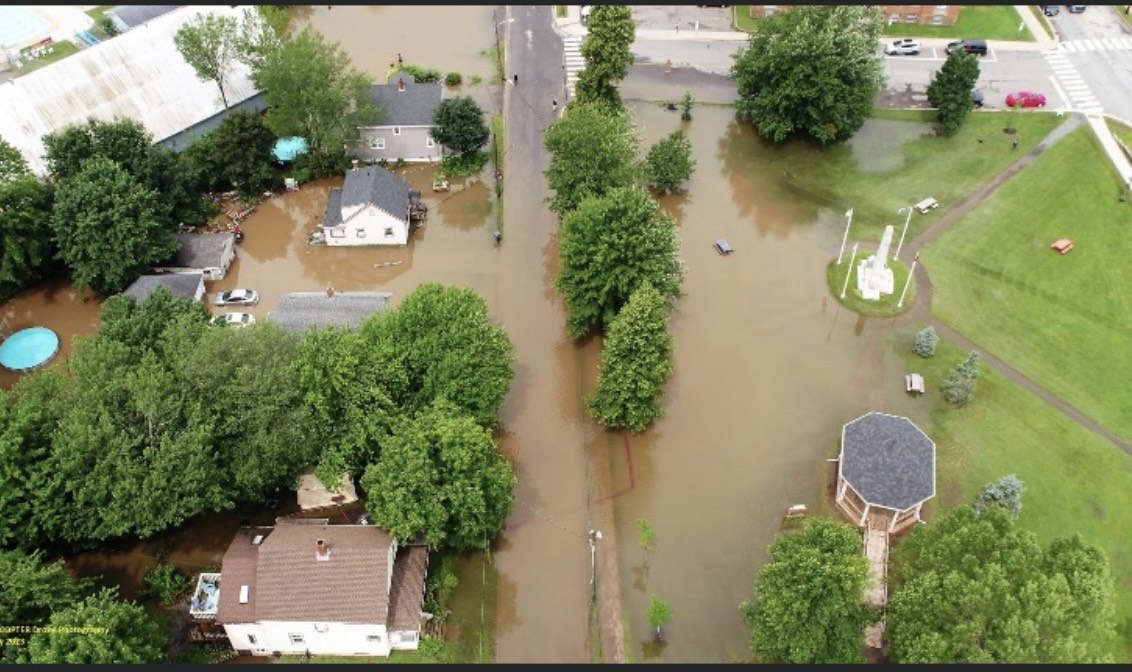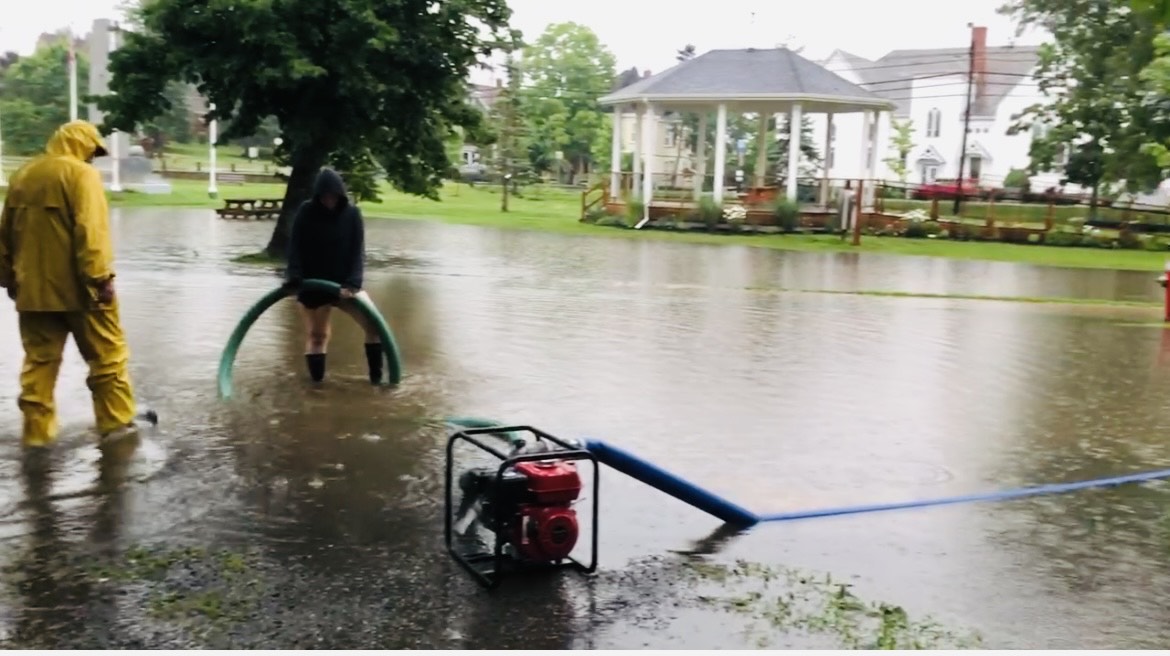Federal financial support for natural disasters expanded, but some still left out
Despite receiving the second-largest federal disaster assistance fund, a Nova Scotia resident feels government help was insufficient.

caption
Rain in 2023 flooded Stannus Street in Windsor, N.S. to waist-deep levels from July 21 to 22.On July 21, 2023, lightning flashed in the night sky as the rain poured. Jennifer Moore, a resident of Windsor, N.S., stood still in waist-deep water.
“I didn’t know what to do, and I just thought there’s no safe space here,” Moore said. “It was a real sense of panic because I knew that every one of my family members [was] outside.”
Moore and her daughter, Melissa Kenny, tried calling their neighbour to check up on her. But no answer. Instead, they tried going to the house directly.
Moore and Kenny felt their feet drenched in dark-brown water as they walked across the road towards their neighbour’s house, 12 metres away. They felt debris with each step, because the catch basin overflowed. Wind, rain, and moving vehicles also obscured them.
From the street, Moore’s son-in-law, Ashton Kenny, saw her illuminated by the lightning.
He yelled, “Go home, go home!”
Moore’s basement flooded within 40 minutes, the water reaching 1.2 meters. Moore lost three vehicles and about $5,000 worth of belongings in her basement, such as a freezer and a dehumidifier.
Nova Scotia experienced the worst flooding recorded in the province in 50 years in 2023, the most recent year for which statistics are available During the most recent fiscal year that ended March 31, 2025, province received more than $182 million, the second-largest amount (behind Alberta) from the federal Disaster Financial Assistance Arrangement (DFAA), according to a search of grants of DFAA.
Nova Scotia received federal assistance for three incidents between 2023 and 2024. The 2023 flood was the worst of these by far (As of July 16th).
The federal government expands financial support for natural disasters
The program offers financial assistance from the federal government for provincial and territorial governments recovering from large-scale natural disasters.
The money allows provincial governments to rebuild infrastructure such as roads and bridges damaged by disasters. Residents can also use the money to repair the damage in their homes.
The federal guideline assesses the significant burden of a disaster based on whether provincial expenses exceeded a per capita amount of $3.84 as of April 1, 2025.
In 2023, Moore applied for the provincial government’s Disaster Financial Assistance program, which only partially covered her lost items. She replaced her items such as a water heater, freezer and dehumidifier. She decided what to prioritize and replaced things before she received the aid since it came out about a year later.
A program reboot
Public Safety Canada modernized the program guidelines earlier this year on April 1. Building on its previous focus on damage recovery, it has now expanded to invest in policies mitigating risk in locations vulnerable to the impacts of natural disasters before the disaster occurs, and mental support for those affected by natural disasters. While the federal government offers funding, provincial and territorial governments can be responsible for building disaster mitigation policies like buying houses in high-risk areas to let residents move to safer places. A province might also offer counselling services for citizens affected by disasters, and those expenses can be requested for federal disaster assistance.
“This is the biggest change in [the program’s] history,” said Brent Doberstein, an associate professor in the Department of Geography and Environmental Management at the University of Waterloo, who studies disaster-risk reduction and post-disaster reconstruction.
“The focus is on mental health and especially vulnerable members of the community who might not previously get any kind of compensation or help,” he said.
Doberstein says collaboration across all levels of government is important. Provincial and territorial governments are responsible for designing policies that mitigate risk in locations vulnerable to the impacts of natural disasters before the disaster occurs and providing services for those affected by natural disasters. They need to work with the federal government closely to ensure the funding is used effectively.
In an emailed response to an interview request about recent changes to its program, Patricia Jreige, acting communications director at Nova Scotia’s Department of Emergency Management, wrote, “We are working with the federal government to roll out the new DFAA Guidelines; however, it’s still too early to discuss what the framework will look like.
Assistance was on Moore’s mind when disaster struck. On the night of July 21, 2023, Moore, who is under five feet tall, remembers being unable to continue walking toward her neighbour’s house. The water reached her chest. She returned home and called the fire department as the water was flooding in, through the window and foundation.
She was worried about her 23-year-old son, Andrew, who had been trying to pump out the overflowing water with a hose. He was waist-deep in the water, and Moore was concerned he could lose his balance.
Moore’s daughter Melissa Kenney, meanwhile, reached the neighbour’s house. She banged on the door without getting an answer. Kenney called 911. She was told there was mass flooding throughout the county and that help would be delayed.
Moore’s son-in-law joined her and pulled off the screen door to bang on the inside door. They finally got her answer and got her out.
A fireman arrived but only stayed a minute and had to move on because “they were overwhelmed with rescues and trying to help people.” She hadn’t realized the serious damage in other areas at that time.
Melissa Kenney went to the community centre across the street for help. All the centre offered was a case of water.
“They’re supposed to be an emergency centre, but they weren’t ready,” Moore said about her daughter’s inability to find help.
The federal program can support the provincial cost of initiatives to ensure life safety, including wellness checks. The cost of setting up emergency coordination centres can also be eligible. However, it is the provincial government or the municipality that carries out the operation and planning to support people affected by disasters.
‘The medium-scale disasters would still be left out’
“The medium-scale disasters would still be left out,” Doberstein said, referring to the federal program designed for large-scale disasters.
Moore and her neighbours, on Stannus Street in Windsor, have experienced combined sewage overflow from the catch basin at the edge of the street since 2021. They endured sewage overflow twice in 2024. Now, they stand on guard whenever 10 minutes of heavy rain is forecasted.

caption
Moore and her neighbours pumped the water out themselves after the flood on July 22, 2023.Moore and neighbours cleaned up their yard and basement themselves after every sewage overflow. They saw the public workers wearing hazmat suits and gas masks cleaning up the community centre across the street, which is the municipal property.
“The best we can do is throw all our clothes away because I don’t want [debris and sewage water] in the house,” Moore said.
In July 2024, Moore fell face-first into the overflowing sewage water after tripping over a large hose. She was trying to help her neighbor pump water out of her yard. Her eyes became dry and itchy. A firefighter suggested she recent hepatitis vaccines, but the cost wasn’t covered. About a week later, she experienced dizziness and blurry vision. She also had a hard time walking because her ears were ringing. Moore and her family felt unwell for six to eight weeks after the flood.
“That seems to be the least concerning of anything, and nobody really seems to be concerned at all,” she said.
Supporting the cost of medical assistance using the normal health infrastructure and resources is eligible for federal disaster assistance. But, only in cases where the volume of patients increased rapidly.
The municipal government launched a Home Flood Protection Pilot Program in 2024 to support the costs of residents who buy equipment to protect their homes from flooding. Moore and her neighbours bought equipment (i.e. pumps and hoses) to pump out the water from the sewage basin, which is the municipal property. However, the equipment cost was not covered by the municipal program because they bought equipment before the program came into effect.
She said the municipality should have an emergency plan, such as setting up a community centre for residents’ relief and reimbursing the cost of the equipment residents spent money on.
In response to her concern, Mark Phillips, chief administrative officer at West Hants Regional Municipality, said there’s a “high level” of cooperation between multiple jurisdictions, such as all the fire services in West Hants. He said they worked together to respond to the initial emergency and ultimately to support the search efforts for those who were lost.
On March 31st, 2025, Hants County got a heavy rainfall warning of total rainfall of 25 to 50 mm.
“We know this is the beginning of the [flooding] season,” Moore said.
Moore and her neighbours had several sleepless nights because they were unsure whether the rain would continue for longer than 10 minutes, which would make the catch basin overflow. It didn’t overflow, but there was still a strong sewage smell.
“Just that smell alone just triggers trauma,” she said, “[My neighbours and I] all need to decompress afterwards because it is stressful and scary, and there’s a lot of trauma.”
About the author

Haruka Ide
Haruka Ide is a Master of Journalism student at King's. She used to work as a TV journalist in Japan.
